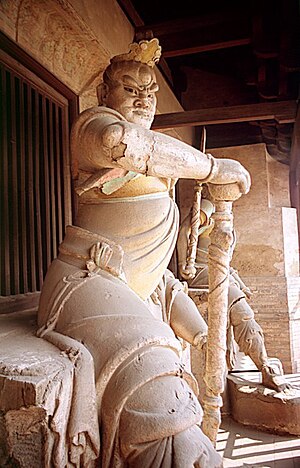Shuanglin Temple
| Shuanglin Temple | |
|---|---|

Terracota sculpture of a temple guardian
|
|
| Basic information | |
| Location | Pingyao |
| Geographic coordinates | 37°10′15″N 112°07′30″E / 37.1708°N 112.125°ECoordinates: 37°10′15″N 112°07′30″E / 37.1708°N 112.125°E |
| Affiliation | Buddhism |
| Province | Shanxi |
| Country | People's Republic of China |
| Completed | 6th century (Qing Dynasty) |
The Shuanglin Temple (Chinese: 双林寺; pinyin: Shuānglín Sì) is a large Buddhist temple in the Shanxi Province of China. It is situated in the countryside of Qiaotou village about 6–7 kilometres (3.7–4.3 mi) southwest of the ancient city of Pingyao. It is among the many cultural monuments located in the Pingyao, which is a UNESCO World Heritage site inscribed in 1997. The temple is protected by the state administration.
Founded in the 6th century, the temple is notable for its collection of more than 2,000 decorated clay statues that are dated to the 12th-19th centuries. Its original name was Zongdu but it was renamed during the Northern Song Dynasty period as Shuanglin. It is nicknamed the museum of coloured sculptures. Most of them are dated to the period of the Song, Yuan, Ming and Qing dynasties.
The Buddhist temple was founded in 571 A.D. during the second year of the Wuping period of the Northern Qi Dynasty. However, the extant buildings date to the Ming and Qing dynasties. It is notable for its collection of over two thousand decorated clay statues dating from the 12th-19th centuries. Shuanglin Temple was refurbished during the cultural revolution of the 20th century under a programme which revived secular culture. It is one of the five sites identified in the city's preservation area of cultural relics which has undergone several renovations. In Pingyao's tortoise-shaped city plan, which is characterized by many coloured art sculptures, the Shuanglin Temple is rated as the city's third treasure.
The Shuanglin Temple is located some six to seven kilometers away from Pingyao, in Qiatou village's countryside.
The sculpted figures are displayed in a very systematic manner, in ten halls. The temple complex appears like a fortress as it has a high compound wall with a gate. The ten halls are arranged within three courtyards.
...
Wikipedia
